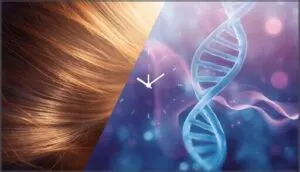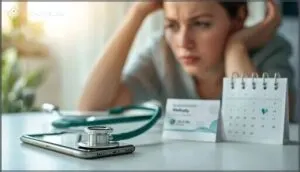This site is supported by our readers. We may earn a commission, at no cost to you, if you purchase through links.
Your hair starts falling out in clumps three months after you stop taking the pill, and suddenly you’re questioning everything. This type of shedding, called telogen effluvium, happens because your body is recalibrating after years of synthetic hormones.
When birth control suppresses your natural hormone production, your hair follicles get used to elevated estrogen levels that keep more strands in the growth phase. Once you stop, estrogen drops, and those protected hairs all shift into the shedding phase at once.
The good news: this process is temporary and reversible for most people. Understanding the timeline of hair growth after stopping birth control helps you distinguish normal hormonal adjustment from conditions that need medical attention.
Table Of Contents
- Key Takeaways
- Can Stopping Birth Control Cause Hair Loss?
- How Hormonal Changes Affect Hair Growth
- What is Telogen Effluvium After Birth Control?
- When Does Hair Loss Start and How Long Does It Last?
- Factors Affecting Hair Recovery After Stopping Birth Control
- How to Support Hair Regrowth at Home
- When to Seek Medical Advice for Hair Loss
- Diagnostic Tests and Treatment Options
- Preventing and Managing Hair Loss After Stopping Birth Control
- Frequently Asked Questions (FAQs)
- Conclusion
Key Takeaways
- Hair loss after stopping birth control is usually telogen effluvium—a temporary shedding phase triggered by dropping estrogen levels that begins 2–4 months post-cessation and resolves within 6–12 months as your hormones rebalance.
- Your recovery timeline depends on ferritin levels (aim for above 70 ng/mL), thyroid function, genetic predisposition to hair loss, and the type of birth control you used—combined pills with estrogen generally cause less severe shedding than progestin-only methods.
- Rising free testosterone converts to DHT after you stop the pill, which can miniaturize hair follicles in genetically susceptible women, making family history of early-onset alopecia or PCOS a key predictor of prolonged shedding.
- Seek medical evaluation if you’re losing more than 150–200 hairs daily, shedding persists beyond six months, or you develop new symptoms like facial hair growth, irregular cycles, fatigue, or patchy bald spots—these signal underlying conditions that need targeted treatment.
Can Stopping Birth Control Cause Hair Loss?
Yes, stopping birth control can trigger noticeable hair loss, and you’re not imagining it if you’re suddenly seeing more strands in your brush. The shift happens because your body is adjusting to the sudden drop in synthetic hormones, which can push hair follicles into a temporary shedding phase.
Here’s what usually happens and why it’s usually not something to panic about.
Common Hair Loss Patterns After Cessation
About 10–50% of you may notice diffuse thinning across your scalp after stopping combined pills, not patchy spots. Shedding onset generally hits 2–4 months post-cessation—classic telogen effluvium driven by hormonal effects on hair. Crown shedding and frontal areas are common, especially if you carry androgen sensitivity.
Regrowth timeline starts around 3–6 months, though full density may take 12–24 months.
To understand people’s experiences, researchers often use qualitative data analysis.
Temporary Vs. Permanent Hair Loss
Post-pill hair loss almost always stems from telogen effluvium, a reversible shedding event without scarring alopecia or permanent follicle miniaturization. Your follicle recovery depends on hormonal stabilization and nutritional support. Regrowth potential remains high because follicles aren’t destroyed—they simply reset their cycle. Supplementary strategies can further aid recovery by addressing indexing limitations.
- Shedding reversibility: Most regain baseline density within 6–12 months as your hormones re-equilibrate
- Miniaturization effects: Unlike androgenetic alopecia, postpill TE doesn’t shrink follicles permanently
- Scarring risk: Zero—telogen effluvium leaves your scalp architecture intact, preserving future hair regrowth
How Birth Control Hormones Affect Hair Follicles
Follicle hormone receptors bind estrogens and progestins differently across contraceptive types. Combined pills deliver synthetic estrogen that extends your anagen phase, keeping more follicles actively growing. When you stop, estrogen drops, hormone levels shift, and 30% of follicles enter telogen simultaneously. Androgens—freed by falling SHBG—shorten the hair growth cycle in susceptible scalps, triggering visible shedding.
| Hormone | Effect on Hair Follicles |
|---|---|
| Estrogen | Prolongs anagen, increases density |
| Progestin | May shorten cycle in sensitive scalps |
| Androgens (DHT) | Miniaturize follicles, accelerate shedding |
| SHBG decline | Unmasks testosterone, worsens hormonal hair cycles |
How Hormonal Changes Affect Hair Growth
When you stop birth control, your hormones don’t simply return to normal overnight. Instead, your body goes through a recalibration period that directly affects your hair follicles and their growth cycles.
Understanding which hormones are at play—and how they shift—helps explain why shedding happens and when you can expect things to settle down.
Role of Estrogen and Progestin in Hair Cycles
Estrogen hair growth thrives when hormone levels stay elevated—your follicles hang on to strands longer, giving you fuller-looking hair. When you stop hormonal contraception, that estrogen support drops, and shedding kicks in as your hair growth cycle resets. Here’s what drives those hormonal fluctuations:
- Estrogen extends anagen, keeping more hairs actively growing
- Progestin androgen activity varies by formulation, affecting shedding patterns
- SHBG levels fall after stopping, freeing testosterone
- Individual hormone response determines your specific timeline
Androgens and Their Impact on Hair Shedding
When free testosterone rises after stopping hormonal contraception, the enzyme 5-alpha-reductase converts it to dihydrotestosterone (DHT)—the hormone most responsible for follicle miniaturization in people with genetic factors for androgenetic alopecia. Your androgen receptors respond to this androgenic activity, and DHT sensitivity varies widely based on inherited traits that determine hormonal changes and hair loss severity.
When you stop birth control, rising testosterone converts to DHT, the hormone that shrinks hair follicles in genetically susceptible people
| Factor | How It Works | Effect on Hair |
|---|---|---|
| DHT | Shrinks follicles over time | Thinner strands, slower growth |
| Androgen receptors | Bind DHT, trigger miniaturization | Density loss, shorter anagen |
| SHBG influence | Drops post-pill, frees testosterone | More substrate for DHT conversion |
| Genetic factors | Determine follicle sensitivity | Predicts shedding risk and pattern |
Changes in SHBG and Testosterone Levels
When you stop combined oral contraceptives, your hormone levels shift in predictable waves. SHBG fluctuation affects how much testosterone circulates freely, and understanding these hormonal changes helps you set realistic expectations for hair regrowth.
- SHBG usually drops below baseline within six to twelve months, raising your free androgen index.
- Total testosterone may climb 10–25% in the first three months as estrogen’s binding effect fades.
- Free testosterone can temporarily spike 15–30% before stabilizing around month three.
- Individual variation—shaped by your weight, age, and lifestyle—determines exactly how your body responds.
What is Telogen Effluvium After Birth Control?
When you stop birth control, your body undergoes a hormonal shift that can push a large number of hair follicles into a resting phase all at once. This phenomenon is called telogen effluvium, and it’s one of the most common reasons women experience increased shedding after discontinuing the pill.
Understanding what triggers it, when it usually occurs, and what signs to watch for can help you manage expectations during this temporary phase.
Definition and Triggers of Telogen Effluvium
When hair suddenly starts shedding in handfuls, you’re likely experiencing telogen effluvium—a temporary condition where hormone withdrawal pushes a large portion of follicles into the resting phase.
This diffuse shedding generally begins 2–4 months after stopping birth control, triggered by dropping estrogen levels.
Recovery timelines generally span 6–12 months once your body rebalances.
Timeline of Shedding After Stopping Birth Control
Most women notice a post-pill hair loss spike around 60–90 days after stopping, peaking at about three months, then tapering off. Here’s what telogen effluvium generally looks like over time:
- Shedding onset begins 2–4 months post-cessation in 40–60% of individuals
- Peak shedding occurs at the 3-month mark for most cases
- Regrowth timeline shows partial recovery by 6 months in 20–40% of people
- Duration factors vary, with shedding returning to baseline within 6–12 months
- Contraceptive type influences hair shedding intensity and timing
Signs and Symptoms to Watch For
You’ll notice diffuse thinning across your entire scalp rather than bald spots, a hallmark of postpill hair loss. Shedding counts climb above 100–150 hairs daily during peak shedding at three to four months, and reduced density becomes visible.
Telogen effluvium from hormonal fluctuations often triggers temporary hair thinning, but many women experience rebound regrowth—though the new strands may feel softer at first.
When Does Hair Loss Start and How Long Does It Last?
The timing of hair loss after stopping birth control follows a predictable pattern, though the exact experience varies from person to person. Most women notice the first signs of increased shedding within a specific window, followed by a peak period before things start to improve.
Understanding this timeline can help you know what’s normal and when to expect your hair to bounce back.
Typical Onset of Shedding Post-cessation
After you discontinue hormonal birth control, telogen effluvium generally announces itself around 8–12 weeks later—a response to hormonal fluctuations that shift follicles into shedding mode.
You’ll notice diffuse shedding across your entire scalp rather than isolated patches.
This postpill hair loss usually lasts 2–6 months before stabilizing, with most cases resolving within 6–12 months as your hair regrowth timeline normalizes.
Peak Shedding Period (3–6 Months)
Between months three and six, shedding peak severity hits hardest—you may lose 30–50% more hairs daily than usual as your hair growth cycle adjusts. This hormonal imbalance drives follicles into synchronized rest. If you have iron deficiency or thyroid dysfunction, postpill hair loss treatment becomes more urgent since these conditions worsen severity and delay anagen re-establishment, stretching your regrowth timeline.
- Daily hair loss increases noticeably during washing and brushing
- Shedding clusters around month four for most users
- Iron levels below 70 ng/mL worsen the problem
- Thyroid irregularities prolong recovery beyond typical windows
- Hair regrowth becomes visible as shedding tapers naturally
Expected Timeline for Regrowth and Recovery
After peak shedding tapers, your hair regrowth generally begins within six to twelve months as hormone levels stabilize and follicles re-enter the growth phase. Full recovery of baseline density often takes twelve to twenty-four months, though individual variation depends on iron stores, thyroid function, and genetic factors.
Hormonal normalization drives this timeline—regrowth factors like adequate protein and ferritin above 70 ng/mL accelerate your hair recovery.
Factors Affecting Hair Recovery After Stopping Birth Control
Not everyone’s hair bounces back on the same schedule after stopping birth control. Your recovery timeline depends on several factors, from what’s written in your genes to what’s happening inside your body right now.
Let’s look at the key players that shape how quickly your hair returns to normal.
Family History and Genetic Predisposition
Your genes shape how your hair responds when you stop the pill. If female hair loss runs in your family—particularly early-onset alopecia or androgenetic alopecia—you may experience more shedding and a longer recovery period.
Family shedding patterns matter too: women with PCOS history or hereditary hair loss often face extended timelines, sometimes influenced by genetic risk factors that intensify hormone-driven hair loss causes.
Nutritional Status (iron, Protein, Vitamins)
Your diet plays a direct role in how quickly your hair bounces back. Low ferritin—ideally below 70 ng/mL—raises your shedding risk two- to three-fold. Protein intake under 1.0 g/kg daily, iron deficiency, and vitamin deficiencies in D or zinc can all stall regrowth.
Biotin supplementation rarely helps unless you’re truly deficient, but antioxidant effects from vitamins C and E may support follicle health in select cases.
Underlying Health Conditions (thyroid, PCOS)
If you have thyroid dysfunction or PCOS, your hair recovery timeline shifts. Twelve to 22% of women with hair loss report thyroid issues, and PCOS-linked hyperandrogenism affects 50–70% of patients.
SHBG reduction from insulin resistance frees more androgens, mimicking androgenetic patterns. Autoimmune thyroid markers worsen shedding.
Hormone normalization can restore regrowth within 6–12 months, though underlying health conditions require targeted treatment.
Type and Duration of Birth Control Used
The birth control you used shapes your hair regrowth path. Combined pills with estrogen-progestin trigger temporary hair shedding in fewer than 5% of users, while progestin-only options show variable responses.
LARC methods like hormonal IUDs may influence shedding during the first six months after removal. Shorter exposure to hormonal birth control often means faster recovery, while non-hormonal methods carry no direct hormonal impact on your hair follicles.
How to Support Hair Regrowth at Home
You don’t need to wait around hoping your hair figures things out on its own. A few targeted steps can give your follicles the support they need during recovery.
Here’s what you can do at home to encourage regrowth and minimize ongoing shedding.
Nutrition and Supplementation (iron, Biotin, Vitamin D)
Your hair regrowth depends partly on what’s fueling it from the inside. Iron deficiency—especially ferritin below 50 ng/mL—can stall recovery and worsen shedding. Correcting low iron often improves hair growth within months.
Vitamin D levels matter too; aim for at least 30 ng/mL. Biotin benefits mainly those who are deficient. Supplement quality and dietary impact count, so choose wisely.
Scalp Care and Gentle Hair Practices
Mechanical stress can push vulnerable follicles over the edge during this delicate phase. Gentle brushing with wide-tooth combs, scalp massage to boost circulation, and checking product ingredients for sulfates help protect your hair while it recovers.
Consider these scalp care routine essentials for hair regrowth strategies:
- Use low-tension protective styling
- Limit heat tools
- Air-dry when possible
- Choose silk pillowcases
- Prioritize hydration matters—both internal and topical
These hair care and maintenance steps reduce breakage and support scalp health as follicles reset.
Stress Management and Lifestyle Tips
Your body needs calm conditions to channel energy toward hair regrowth. Reduce stress through daily mindfulness or deep breathing—studies show cortisol drops 10–20% with consistent practice.
Improve sleep to 7–9 hours nightly, which lowers shedding by 12–18%. A balanced diet rich in protein and regular exercise benefits circulation.
These lifestyle changes collectively support recovery after birth control.
When to Seek Medical Advice for Hair Loss
Most shedding after stopping birth control resolves on its own, but certain patterns warrant a closer look. You shouldn’t ignore signs that point to something more serious than temporary telogen effluvium.
Here’s when you need to call your doctor or a hair specialist instead of waiting it out.
Signs of Abnormal or Severe Hair Shedding
When should a handful of stray hairs raise concern? Excessive Daily Shedding—losing more than 150–200 hairs per day—signals telogen effluvium that may need attention. Watch for these hair shedding symptoms:
- Diffuse Scalp Thinning visible across your entire scalp, not just one area
- Sudden Shedding Onset appearing 2–4 months after stopping your pill
- Trichoscopy Findings showing uniform miniaturization without scarring
- Persistent Shedding Duration extending beyond six months post-cessation
These female hair loss causes warrant evaluation.
Symptoms Suggesting Underlying Conditions
Beyond shedding alone, watch for hormonal imbalance signals that point to deeper issues. New facial hair, acne flares, or irregular cycles suggest PCOS symptoms. Cold intolerance, fatigue, or weight shifts flag thyroid disorders. Patchy bald spots with scalp inflammation raise suspicion for autoimmune disease.
Brittle nails and pale skin can indicate iron deficiency or other nutrient deficiencies—all warrant thyroid dysfunction and autoimmune marker testing.
Role of Dermatologists and Trichologists
When symptoms suggest something beyond routine post-pill shedding, a dermatologist offers diagnostic referrals, dermoscopy value, and treats most telogen effluvium cases with targeted therapies. A trichologist specialization focuses on scalp health and non-medical hair care for cosmetic concerns.
Collaborative outcomes between dermatology and trichologist expertise improve hair loss diagnosis, hair regrowth timelines, and patient satisfaction—especially when shedding persists or patterns look unusual.
Diagnostic Tests and Treatment Options
If your hair isn’t bouncing back as expected, your doctor can order targeted tests to find the root cause. Blood work commonly checks ferritin, thyroid function, and hormone levels to rule out deficiencies or imbalances.
Once you have answers, treatment options range from prescription medications to over-the-counter supplements, each with different levels of evidence behind them.
Recommended Blood Tests (ferritin, Thyroid, Hormones)
Targeted blood work can pinpoint hormonal triggers behind persistent shedding. Start with ferritin—levels below 40 ng/mL often fuel hair loss diagnosis, even when you’re not anemic.
Add thyroid assessment (TSH, free T4, anti-TPO antibodies) to catch thyroid issues that quietly disrupt growth cycles.
Test free testosterone, SHBG, and DHEAS to map hormone imbalance, especially if facial hair or acne appeared after stopping the pill.
Topical and Prescription Treatments
Once blood tests reveal the underlying trigger, topical minoxidil (2% or 5%) becomes your go-to option—40–60% of users see noticeable hair regrowth within a year. If androgen activity drives your shedding, oral spironolactone can improve density in 20–40% of women over six to twelve months.
PRP injections, LLLT devices, and ketoconazole shampoo offer adjunct support for hormonal hair loss treatment when standard female hair loss solutions need reinforcement.
Over-the-counter Supplements and Efficacy
Most shelves overflow with biotin, vitamin D, and zinc supplements promising faster hair regrowth, yet evidence remains mixed. Iron repletion works when your ferritin sits below 30 ng/mL, but biotin effectiveness and vitamin D outcomes lack strong trial support. Saw palmetto and omega fatty acids show minimal proof.
Focus on:
- Correcting documented deficiencies
- Choosing third-party-tested products
- Consulting your provider before stacking multiple formulas
Preventing and Managing Hair Loss After Stopping Birth Control
You can’t stop your body from reacting to hormone withdrawal, but you can soften the impact. A few thoughtful steps before and after you stop birth control make a real difference in how much hair you shed and how quickly it bounces back.
The strategies below focus on preparation, smart transitions, and habits that keep your hair healthy for the long run.
Strategies to Minimize Shedding Risk
You can cut your hair shedding risk before stopping birth control by checking a few basics. Ferritin optimization—aiming for levels above 70 ng/mL—aids hair loss prevention, while protein intake around 0.8–1.0 g/kg daily fuels regrowth.
Vitamin D sufficiency, thyroid screening for underlying conditions, and stress management all help minimize birth control side effects.
Gentle practices like loose styles reduce mechanical damage during nutritional support for hair growth.
Planning for Contraception Transitions
Before you switch contraception options, map your timeline and pick a method that won’t shock your system. Gradual cessation—tapering hormonal birth control over three cycles if possible—can soften the hormonal impact and reduce hair loss risk.
Discuss alternative methods like non-hormonal IUDs or barrier options with your clinician; changeover planning smooths the shift and protects your follicles during the change.
Long-term Hair Health Maintenance
Once your hair recovers, keep it that way with consistent care that bolsters your hair growth cycle and furthers hair follicle health. Regular scalp massage, sulfate-free cleansers, and stress reduction habits maintain scalp health while respecting genetic influence on your baseline density.
- Monitor iron and ferritin levels annually to catch deficiencies early
- Prioritize nutritional support with adequate protein, zinc, and vitamin D
- Schedule gentle trims and avoid tight styles that stress regrowing strands
Frequently Asked Questions (FAQs)
Does hair texture change after stopping birth control?
Yes, about 46% of women notice texture shifts—often increased frizz or coarseness—within six months. These changes reflect temporary sebum production spikes and estrogen influence, generally resolving as hormones stabilize over three to six months.
Can hair color shift when hormones rebalance?
Some people notice subtle pigment changes during hormonal rebalance, though documented shifts are rare.
Estrogen and androgen fluctuations can influence melanin production temporarily, but most color variations remain minor and within normal range.
Will taking collagen help speed up regrowth?
Think of collagen like a scaffolding for a building—its structural role doesn’t guarantee it’ll speed up hair regrowth.
Clinical evidence shows no consistent anagen promotion or faster hair recovery compared to addressing nutritional gaps directly.
Should I switch shampoos during the shedding phase?
You don’t need to switch shampoos just because you’re shedding. Gentle formulas that support scalp health work fine.
Focus on avoiding scalp irritation and harsh ingredients rather than chasing special cleansing routines.
Are there specific hairstyles that prevent breakage?
While tight ponytails snap strands under pressure, low-tension styles like loose braids preserve hair volume and density.
Protective hairstyles reduce breakage by 20–30%, especially when you rotate them weekly and apply smoothing products to fragile ends.
Conclusion
Your body knows how to recover—it just needs time to remember its rhythm. Hair growth after stopping birth control follows a predictable arc: temporary shedding, followed by gradual renewal as your natural hormones stabilize.
Most people see meaningful regrowth within six to twelve months. If your timeline differs noticeably, or shedding intensifies beyond the expected window, that’s when professional guidance matters.
Trust the process, support your system with good nutrition, and watch your hair find its way back.














